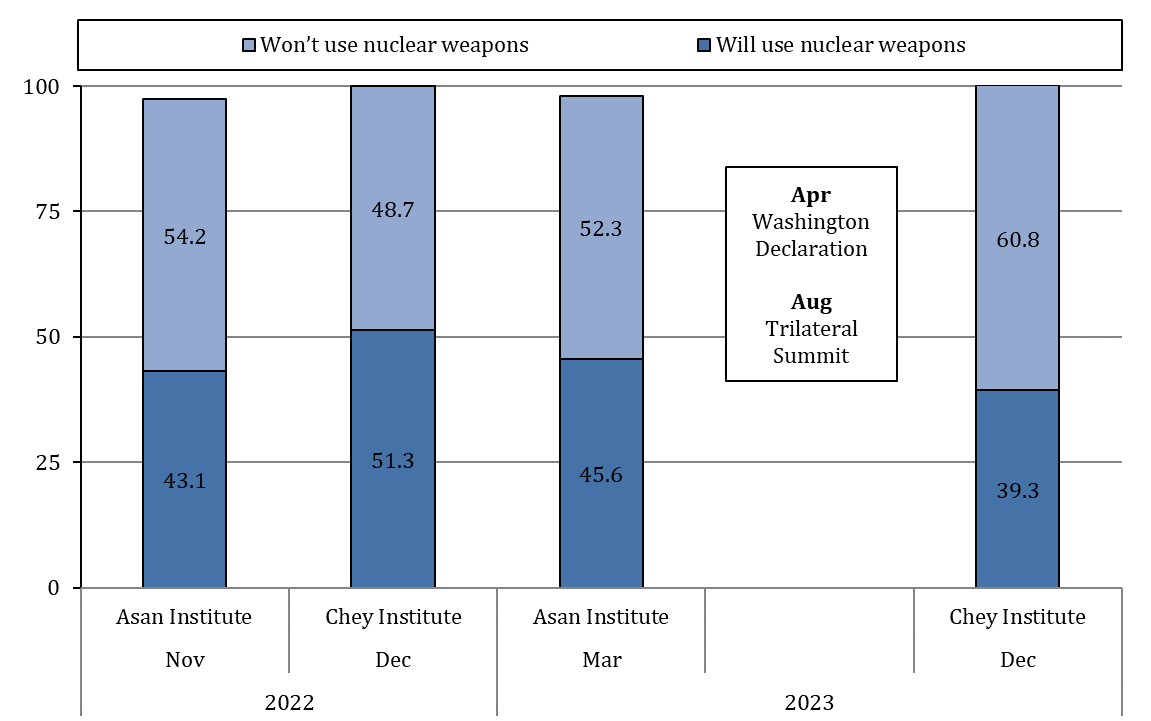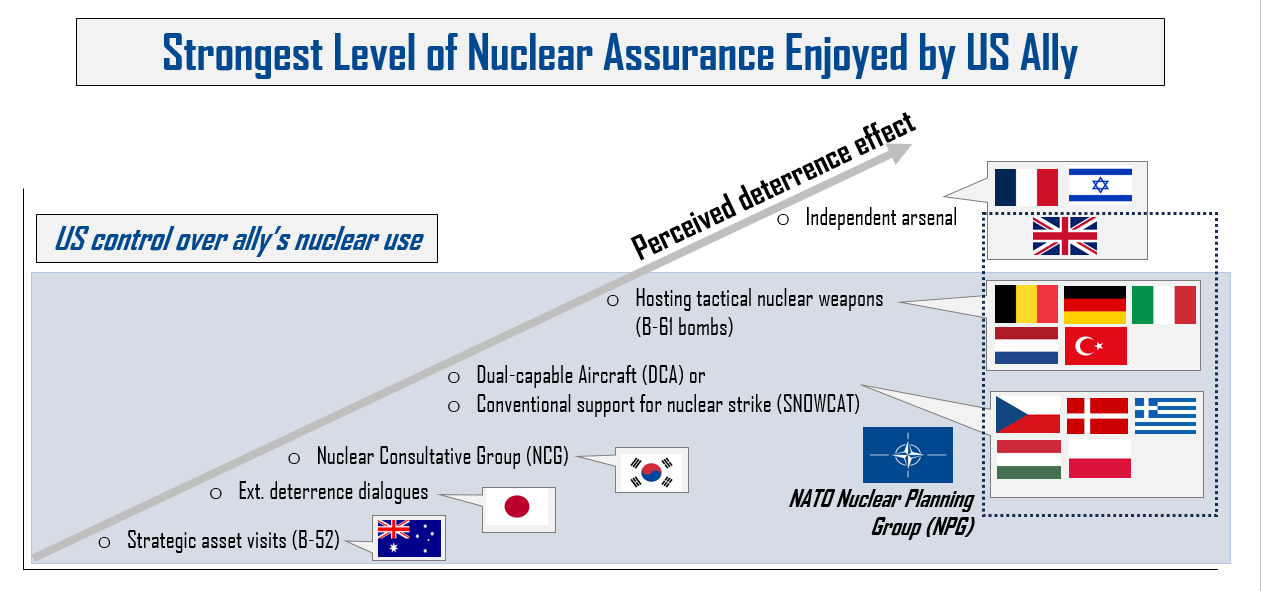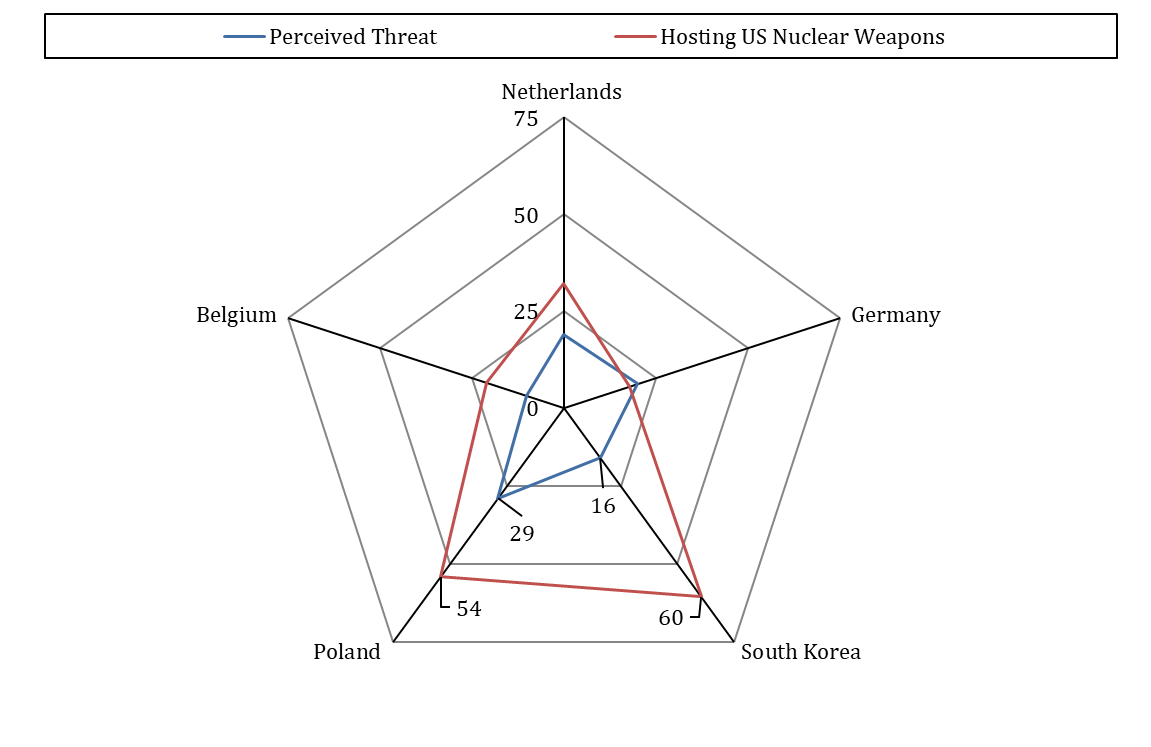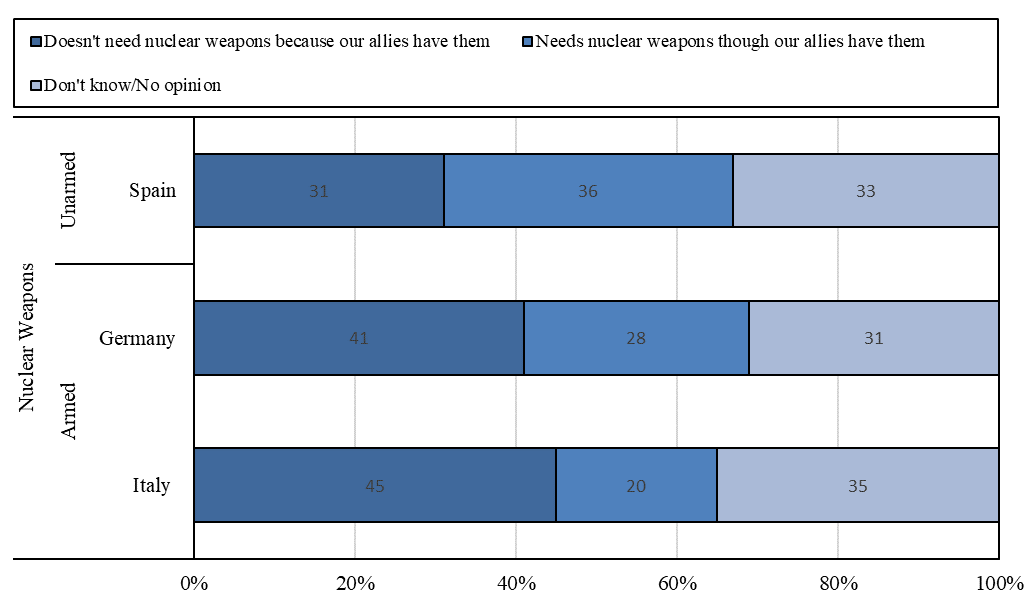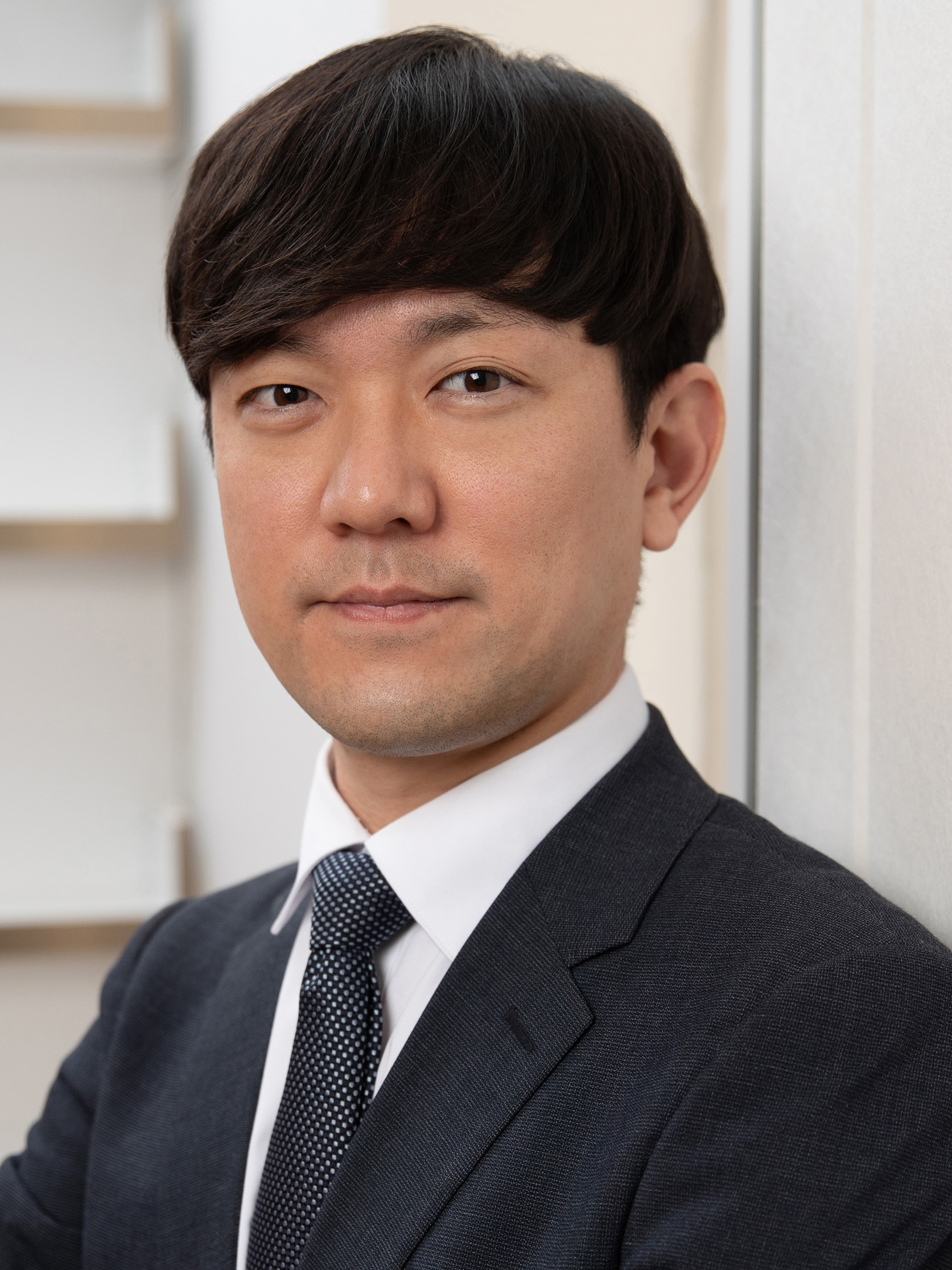Introduction
Almost a year since the United States promised to strengthen its extended nuclear deterrence commitment to the Republic of Korea as part of the Washington Declaration, South Korean public confidence in the credibility of U.S. nuclear assurances has not increased. In fact, survey results show that it has actually decreased. The lack of South Korean public confidence in the current U.S. nuclear assurance manifests itself in strong support for both the redeployment of U.S. tactical nuclear weapons as well as the acquisition of an independent nuclear weapons capability. Recent surveys have concluded that the public is committed to pursuing a nuclear arsenal regardless of what the United States offers or threatens to do. This has undermined U.S. trust in nuclear cooperation with the ROK. However, much of the commentary has lacked relevant cross-regional context to determine whether such sentiments are an outlier or the norm amongst U.S. allies.
This Asan Issue Brief compares public confidence in the U.S. extended nuclear deterrence commitment across allies in the Indo-Pacific and Euro-Atlantic regions to put South Korean public opinion in comparative context. This is because the United States continues to deploy B61 nuclear gravity bombs in Europe while refusing to redeploy them in the Indo-Pacific. U.S. allies who face direct security threats but lack concrete nuclear assurances such as South Korea and Poland have lower confidence in U.S. credibility. This Issue Brief argues that current South Korean support for independent nuclear armament reflects a condition in which the ROK lacks the kind of nuclear assurances provided to European allies. Put simply, if the ROK had the same level of extended deterrence arrangement as that enjoyed by European allies, then there may be similarly low support for independent nuclear armament as in Europe. This is an important distinction because it suggests that while South Korean opinion superficially appears like an extreme outlier, it in fact sits within the norm of allied public sentiment.
The Issue Brief proceeds as follows. First, it discusses why South Korean public confidence in the U.S. commitment has not significantly improved since the 2023 Washington Declaration. By comparing U.S. extended deterrence commitments among allies, it shows that high threat perceptions and a lack of concrete deterrence measures lead to support for stronger nuclear assurances in the cases of the ROK and Poland. Second, it discusses recent survey experiments which show dual South Korean support for redeploying U.S. tactical nuclear weapons and acquiring independent nuclear weapons. A cross-national analysis of confidence in U.S. extended deterrence commitments suggests that South Korean views are not an outlier. Instead, they reflect the current reality in which the country faces a direct nuclear threat but lacks the kind of concrete nuclear assurances that other U.S. allies enjoy. The Issue Brief concludes by discussing the implications of these findings and recommends ROK-U.S. discussions on thresholds for moving to more advanced extended deterrence arrangements.
1. South Korean Anxieties about U.S. Nuclear Assurances in Comparative Context
A majority of the South Korean public has long questioned whether the United States would fulfill its pledge to use nuclear weapons in response to a nuclear attack on the ROK. The Asan Institute’s surveys in 2022 and March 2023 found that, when asked “Do you think the U.S. would use nuclear weapons to defend South Korea even if it means risking its security?”, less than half of South Koreans agreed (2022: 43.1%; 2023: 45.6%).1 In January 2023, ROK President Yoon Suk Yeol broke a longstanding taboo when he stated that Seoul might be forced to “introduce tactical nuclear weapons or build them on our own” in the face of increasing North Korean nuclear threats.2 The message was received loud and clear in Washington.
In April 2023, the ROK and the United States announced the Washington Declaration to strengthen extended nuclear deterrence.3 Among a range of measures, the two countries established a Nuclear Consultative Group (NCG) which seemed similar to the Nuclear Planning Group (NPG) between the United States and its North Atlantic Treaty Organization (NATO) allies. U.S. nuclear strategic assets have since been deployed nine times to the Korean Peninsula, compared to none in 2021 and only once in 2022.4 This included the first ballistic missile submarine (SSBN) to visit the ROK in 40 years.
Following the Washington Declaration, ROK Deputy National Security Advisor Kim Tae-hyo re-assured the South Korean public that, the joint declaration will make the people “feel that they are sharing nuclear weapons with the United States.”5 However, South Korean public confidence in the U.S. extended nuclear deterrence commitment has actually declined, not increased. A December 2023 survey by the Chey Institute for Advanced Studies found that confidence had dropped by 6 percentage points to 39.3%.6 In short, South Korean confidence in the credibility of the U.S. extended deterrence commitment remains low.
Figure 1. Expected U.S. Nuclear Response to a North Korean Nuclear Attack7 (%)
The ROK-U.S. nuclear debate is not happening in isolation. It is often overlooked that U.S. allies vary widely in terms of their extended deterrence arrangement with the United States.8 U.S. allies include those possessing their own nuclear arsenals such as the United Kingdom, France, and Israel. U.S. B61 nuclear gravity bombs are also stationed in Belgium, Germany, Italy, the Netherlands, and Turkiye under so-called ‘nuclear sharing’ arrangements. In addition to these countries, other European allies either provide dual-capable aircraft (DCA) to carry U.S. tactical nuclear weapons or play a supporting conventional role under the Support of Nuclear Operations With Conventional Air Tactics (SNOWCAT), including the Czech Republic, Denmark, Greece, Hungary, and Poland.9
Figure 2. Level of U.S. Extended Deterrence Arrangement
Source: Compiled by authors.
In the Indo-Pacific, by contrast, U.S. allies no longer host tactical nuclear weapons which were withdrawn from Taiwan in 1974, the Philippines in 1986, and South Korea in 1991. Today, allies including South Korea, Japan, and Australia instead rely on occasional visits by U.S. nuclear strategic assets and engage in various types of discussions with the United States. Figure 2 conceptually shows how some of these measures increase the deterrent value of nuclear weapons, including the strongest level of nuclear assurance by selected U.S. allies. Importantly, the United States continues to enjoy full control over the use of nuclear weapons in all cases short of an independent nuclear capability, as denoted by those countries covered by gray shading.
Why does the South Korean public not feel assured by the important steps that the United States has taken as part of the Washington Declaration? There are many potential factors at play, including the perceived inadequacy of individual U.S. measures, a general lack of confidence in U.S. nuclear strategy, overall trust in the United States and leader favorability, North Korea’s tactical nuclear capabilities and threats, the specter of Russian and Chinese nuclear weapons, and more. We choose to focus on perceived threat and support for hosting U.S. tactical nuclear weapons as one cross-regional comparison to illustrate the broader relationship between extended deterrence measures and public confidence (See Figure 3). A public can answer whether another state poses a direct threat to their security, either nuclear or non-nuclear.
Allied publics who state the highest levels of perceived threat but do not host U.S. tactical nuclear weapons are most in favor of enhanced nuclear weapons cooperation with the United States. Publics in South Korea and Poland appear to be more insecure (South Korea 16%, Poland 29%) under the threats from North Korea and Russia, respectively. But they both currently lack concrete nuclear assets deployed in their countries. A March 2023 Asan Institute survey found a majority of South Koreans support hosting U.S. tactical nuclear weapons (60.4%).10 Meanwhile, 54.1% of Polish respondents said Poland should participate in NATO’s ‘nuclear sharing’ arrangements which would allow them to have more tangible control over nuclear weapons (oppose 29.5%).11 According to a global survey by the European Council on Foreign Relations in September 2023, 56% of South Koreans support having “access to” nuclear weapons (oppose 24%, neither 18%).12
For South Koreans, it is not clear whether U.S. extended deterrence commitments as part of the Washington Declaration are thus far sufficient to deter North Korea’s direct and explicit nuclear threats. Meanwhile, despite Russia’s invasion of Ukraine and threats to use nuclear weapons as part of its military campaign, it has not yet made any direct threats to preemptively use nuclear weapons against any of the U.S. allies who host U.S. B61 nuclear bombs. As shown in Figure 3, this partly explains why majorities of Belgians, Dutch, and Germans who report low level of perceived threat also oppose hosting US nuclear weapons.
Figure 3. Perceived Threat and Support for Hosting U.S. Nuclear Weapons13
2. Re-evaluating South Korean Support for Independent Nuclear Weapons
Some U.S. allies face direct security threats but lack the kind of robust nuclear assurances that Western European allies enjoy such as hosting U.S. B61 gravity bombs. In the South Korean case, this public insecurity manifests itself in strong support for stronger extended deterrence measures. Recent studies of South Korean public opinion have found support for both the redeployment of U.S. tactical nuclear weapons as well as the acquisition of an independent nuclear weapons capability.14 This has been interpreted to suggest that a majority of the South Korean public is fundamentally committed to seeking nuclear weapons regardless of what the United States might do to strengthen its extended nuclear deterrence commitment.15 For example, a widely cited 2022 U.S. survey found that when asked to choose between two nuclear armament options, South Koreans “overwhelmingly prefer an independent arsenal (67%) over U.S. deployment (9%).”16 This appears to be consistent even if the U.S. provides stronger assurances, offers to forward deploy its nuclear weapons, or threatens to sanction South Korea.17
South Korean public opinion appears fundamentally committed to seeking nuclear weapons regardless of what the United States might do.18 This has undermined U.S. willingness to pursue any nuclear cooperation with South Korea that might inadvertently pave the way for an independent ROK nuclear weapons capability.19 We join this debate by offering a cross-national comparison of extended deterrence and its confidence across U.S. allies. Much of the commentary has lacked relevant cross-regional context to determine whether such sentiments are an outlier or the norm amongst U.S. allies. As this Issue Brief has shown, public confidence in the U.S. commitment varies depending on the type of deterrence arrangement. Current South Korean support for independent nuclear armament may reflect a condition in which the ROK lacks the kind of nuclear assurances provided to European allies.
Figure 4 shows selected responses regarding European public confidence in U.S. extended deterrence relative to the need for an independent nuclear weapons capability. As shown in the survey conducted after Russia’s invasion of Ukraine Italy and Germany which both host U.S. B61 nuclear gravity bombs show higher confidence (Italy 45%, Germany 41%) compared to Spain (31%), which does not host U.S. nuclear weapons. The three countries vary in their proximity and level of threat perception towards Russia. This suggests that a lack of concrete nuclear assurances in the form of B61 gravity bomb deployment plays a critical role in shaping public confidence in U.S. assurances.
Figure 4. European Public Confidence in the U.S. Nuclear Umbrella20 (%)
Rather than a genuine desire for independent nuclear armament, we hypothesize that South Korean public opinion may instead reflect a well-justified lack of confidence in the current U.S. extended deterrence policy settings vis-à-vis other allies. That is, if South Korea came to have the same level of extended deterrence arrangement as that some European allies such as Germany or Italy enjoy, then there might be lower support for nuclear armament. This helps to explain why South Korean opinion superficially appears like an outlier but in fact sits within the norm of U.S. allied public sentiment.
South Koreans may only want to strengthen an allied nuclear deterrence over which they have greater sovereign control, much like other U.S. allies in NATO. This assumption was also consistent with high public support for global disarmament. In 2023, 68.2% of South Koreans said they agree with abiding by the Nuclear Non-Proliferation Treaty (NPT), implying there is little interest in becoming an international pariah by violating international agreements.21 In summary, South Korean support for hosting U.S. nuclear weapons and also developing their own nuclear weapons could be because they currently lack both options, not because they necessarily want both. We can only really know the true support for independent nuclear armament if we conduct a survey after the United States redeployed tactical nuclear weapons to South Korea.
3. Policy Implications and Recommendations
The preceding analysis leads to important insights that commentators have overlooked to date. It should be noted that this Issue Brief is primarily concerned with public confidence in U.S. nuclear assurances, not the operational utility of tactical nuclear weapons. We acknowledge that public support in host nations is only one factor in determining U.S. nuclear strategy and extended deterrence commitments. But just as a coalition of allies successfully advocated against the adoption of a ‘no first use’ policy in the 2022 U.S. Nuclear Posture Review, the elite and public sentiments of allies do matter.22 The United States has long resisted requests to redeploy tactical nuclear weapons in the Western Pacific on the basis that they do not make a difference to existing U.S. commitments.23 Even if this were true from an operational standpoint, it has not effectively convinced a majority of the South Korean public.
ROK-U.S. alliance managers need to pay attention to both extended nuclear deterrence and credible nuclear assurances. From a public opinion standpoint, U.S. credibility ultimately depends on deterrence measures being visible and tangible. Strategic ambiguity is no longer effective. Current South Korean public anxiety about U.S. extended deterrence stems from a lack of comparable and concrete assurances like those provided to European U.S. allies. ROK and U.S. officials therefore need to explain in clearer detail the operational benefits of current NCG activities for U.S. extended deterrence and why they believe these measures are comparable to NATO arrangements. At the moment, these U.S. steps have the appearance of being one-off or isolated events, such as a SSBN port visit or a B52 strategic bomber landing, rather than incremental measures as part of a broader nuclear strategy.
The ROK and the United States also need to continue discussions on determining the operational thresholds under which the ROK-U.S. alliance might need to adjust to a different extended deterrence arrangement more similar to that found in Europe. Put simply, under what conditions and threats from North Korea would the U.S. consider a SNOWCAT-style arrangement with the ROK under which would it consider a redeployment of B61 gravity bombs? What do policymakers in these countries consider a minimum required capability to be assured of the U.S. extended deterrence commitment? Recent research by the Asan Institute and RAND Corporation has postulated a minimum force of eight to 12 B-61 nuclear bombs redeployed to the ROK would be sufficient.24
Conclusion
Nuclear-armed authoritarian regimes are testing the credibility of U.S. extended nuclear deterrence commitments to its allies in the Indo-Pacific and Euro-Atlantic regions, not just on the Korean Peninsula. In response, the Biden administration has taken major steps to strengthen extended deterrence as part of its 2022 Nuclear Posture Review.25 This includes modernizing the nuclear strategic triad to the cost of $US 1.5 trillion.26 It also involves the construction of a new B61-13 variant of its existing nuclear gravity bombs.27 The Washington Declaration is an important if overdue step in reconciling the U.S. prioritization of operational effectiveness and the ROK desire for more tangible control. As North Korean nuclear capabilities advance, the South Korean public nonetheless needs more visible and concrete reassurance measures from the United States. U.S. allies need some element of control over the nuclear weapons that are meant to ensure their survival. The United States should consider calibrating its operational nuclear force posture to achieve a better equilibrium across regions and fit with current public sentiment.
The views expressed herein do not necessarily reflect the views of the Asan Institute for Policy Studies.
- 1. Source: Asan Poll (March 2023). James Kim, Kang Chungku, and Ham Geon Hee, “Transitioning Attitudes on North Korea: Perceived Threat and Preferred Response,” The Asan Institute for Policy Studies (April 21, 2023), https://en.asaninst.org/contents/transitioning-attitudes-on-north-korea-perceived-threat-and-preferred-response/. See Figure 7.
- 2. Choe Sang-Hun, “In a First, South Korea Declares Nuclear Weapons a Policy Option,” The New York Times (January 12, 2023), https://www.nytimes.com/2023/01/12/world/asia/south-korea-nuclear-weapons.html. Similar sentiments have been expressed by the leaders of other U.S. strategic partners such as Saudi Arabia who have even weaker security guarantees and extended deterrence arrangements. Julian Borger, “Crown Prince Confirms Saudi Arabia Will Seek Nuclear Arsenal If Iran Develops One,” The Guardian (September 21, 2023), https://www.theguardian.com/world/2023/sep/21/crown-prince-confirms-saudi-arabia-seek-nuclear-arsenal-iran-develops-one.
- 3. The White House, “Washington Declaration” (April 26, 2023), https://www.whitehouse.gov/briefing-room/statements-releases/2023/04/26/washington-declaration-2/.
- 4. Eunjung Lee, “Nuclear 3 Axis Strategic Assets Deployed 9 Times This Year Alone… Strengthened Warning Against North Korea,” Yonhap News TV (November 8, 2023). https://www.yonhapnewstv.co.kr/news/MYH20231108000200641?input=1825m.
- 5. Byun Duk-kun, “Washington Declaration Will Help Deter NK Threat but not ‘Nuclear Sharing’ Agreement: U.S. Official,” Yonhap News (April 28, 2023), https://en.yna.co.kr/view/AEN20230428003200325#:~:text=The%20official%20noted%20the%20agreement,is%20not%20%22nuclear%20sharing.%22.
- 6. The survey asked: “Do you believe that the U.S. would exercise nuclear deterrence in the event of a contingency on the Korean Peninsula, even at the risk of potential nuclear attacks against the U.S., given that North Korea has the capabilities to target the U.S. mainland?”
- 7. Question wordings in Korean are as follows: (a) Asan Institute: “선생님께서는 북한의 핵 공격 시, 미국이 자신의 위험을 감수하고 우리나라를 위해 핵무기를 사용할 것으로 생각하십니까?”, (b) Chey Institute: “북한이 ICBM, SLBM, MIRV 등의 미사일 개발을 통해 미국 본토에 대한 공격이 가능한 상황에서 미국이 자국에 대한 북한의 핵 공격 가능성을 무릅쓰고 한반도 유사시 핵 억지력을 행사할 것이라고 생각하십니까?”
- 8. Ivo H. Daalder, Chuck Hagel, Malcolm Rifkind, and Kevin Rudd, “Preventing Nuclear Proliferation and Reassuring America’s Allies,” The Chicago Council on Global Affairs (February 10, 2021), https://globalaffairs.org/research/report/preventing-nuclear-proliferation-and-reassuring-americas-allies.
- 9. Some sources also include Norway and Romania, while others do not. For the sake of clarity, they are omitted from this chart. Hans M. Kristensen, Matt Korda, Eliana Johns, and Mackenzie Knight, “Nuclear Weapons Sharing, 2023,” Bulletin of the Atomic Scientists 79, no. 6 (November 2, 2023): 393–406. https://doi.org/10.1080/00963402.2023.2266944; Wieslaw Gozdziewicz, “Nuclear Deterrence,” NATO Joint Warfare Centre, The Three Swords 39/2023, https://www.jwc.nato.int/download_file/view/2310/277.
- 10. Asan Institute, “South Koreans and Their Neighbors 2023.” The Asan Institute for Policy Studies (April 26, 2023), https://en.asaninst.org/contents/south-koreans-and-their-neighbors-2023/.
- 11. Adrian Andrzejewski, “Majority of Poles Wants Poland to Participate in ‘Nuclear Sharing’ Programme,” Dignity News (October 12, 2022), https://dignitynews.eu/en/majority-of-poles-wants-poland-to-participate-in-nuclear-sharing-programme/.
- 12. Timothy Garton Ash, Ivan Krastev, and Mark Leonard, “Living in an à la carte World: What European Policymakers Should Learn From Global Public Opinion,” European Council on Foreign Relations (November 15, 2023), https://ecfr.eu/publication/living-in-an-a-la-carte-world-what-european-policymakers-should-learn-from-global-public-opinion/.
- 13. On Perceived threat, See: Ipsos Global Advisor, “What Worries the World- February 2024,” Ipsos (February 27, 2024), https://www.ipsos.com/en/what-worries-world. It was those who chose ‘military conflict between nations’ to the question, “Which three of the following topics do you find the most worrying in your country?” Average rating was 10% and the most worried nation was Israel (45%).; On Belgium, Netherlands and Germany, See: ICAN, “Polls: Public Opinion in EU Host States Firmly Opposes Nuclear Weapons,” The International Campaign to Abolish Nuclear Weapons (April 2019), https://www.icanw.org/polls_public_opinion_in_eu_host_states_firmly_opposes_nuclear_weapons. Question wording is as follows: “There are nuclear weapons that are currently stationed in your country. Do you think U.S. nuclear weapons should be removed from your country’s territory or should they stay?”
- 14. David M. Allison, Stephen Herzog, and Jiyoung Ko, “Under the Umbrella: Nuclear Crises, Extended Deterrence, and Public Opinion.” Journal of Conflict Resolution, 66, no. 10 (2022); Lauren Sukin, “Credible Nuclear Security Commitments Can Backfire: Explaining Domestic Support for Nuclear Weapons Acquisition in South Korea,” Journal of Conflict Resolution, 64, no. 6 (2020); Lee Kyung-suk, “The Microfoundations of Nuclear Proliferation: Evidence from South Korea,” International Journal of Public Opinion Research, 35, no. 1 (2023).
- 15. Michelle Ye Hee Lee, “South Koreans Overwhelmingly Want Nuclear Weapons to Confront China and North Korea, Poll Finds,” The Washington Post (February 21, 2022), https://www.washingtonpost.com/world/2022/02/21/south-korea-nuclear-weapons/; Dasl Yoon and Timothy W. Martin, “South Korea’s Interest in Nuclear Weapons Hasn’t Gone Away—It’s Just On Hold,” The Wall Street Journal (September 16, 2023). https://www.wsj.com/world/asia/south-koreas-interest-in-nuclear-weapons-hasnt-gone-awayits-just-on-hold-7c91cf8a.
- 16. Toby Dalton, Karl Friedhoff, and Lami Kim, “Thinking Nuclear: South Korean Attitudes on Nuclear Weapons,” The Chicago Council on Global Affairs (February 21, 2022), https://globalaffairs.org/research/public-opinion-survey/thinking-nuclear-south-korean-attitudes-nuclear-weapons?gad_source=1&gclid=CjwKCAiA3JCvBhA8EiwA4kujZquVYz1wNoqSOPFgO7hfOMBGvYglxZPNP1HgT2QvaaaQLskLtZIKwBoCNqoQAvD_BwE.
- 17. Lauren Sukin, “Credible Nuclear Security Commitments Can Backfire: Explaining Domestic Support for Nuclear Weapons Acquisition in South Korea.”
- 18. Sangmi Jeong, “Analyzing South Korean Attitudes Towards Nuclear Armament (in Korean),” Korea National Diplomatic Academy (January 2, 2024) [정상미, “한국민의 자체 핵무장 지지 여론 분석,” 주요국제문제분석 2023-44, 국립외교원 외교안보연구소], https://www.ifans.go.kr/knda/ifans/kor/pblct/PblctView.do?csrfPreventionSalt=null&pblctDtaSn=14265&menuCl=&clCode=P01&koreanEngSe=KOR&pclCode=&chcodeId=&searchCondition=searchAll&searchKeyword=&pageIndex=1.
- 19. Toru Tsunashima and Junnosuke Kobara, “Can Washington and Seoul tame South Koreans’ nuclear ambitions?,” Nikkei Asia (December 31, 2023), https://asia.nikkei.com/Politics/Defense/Can-Washington-and-Seoul-tame-South-Koreans-nuclear-ambitions. Ernest J. Moniz, “A Nuclear South Korea is a Dangerous Miscalculation,” Foreign Policy (April 25, 2023), https://foreignpolicy.com/2023/04/25/south-korea-biden-yoon-summit-nuclear-weapons-energy-alliance-defense/. Jennifer Ahn, “Challenges ahead for US efforts to quell South Korea’s nuclear ambitions,” East Asia Forum (June 3, 2023), https://eastasiaforum.org/2023/06/03/challenges-ahead-for-us-efforts-to-quell-south-koreas-nuclear-ambitions/.
- 20. Matthew Kendrick, “U.S. Allies Trust the American Nuclear Umbrella, Even If They Hate Nuclear Weapons,” Morning Consult (August 30, 2022), https://pro.morningconsult.com/instant-intel/united-states-allies-nuclear-weapons-umbrella-trust-survey. Survey conducted during August 16~17, 2022.
- 21. Lee Sang-sin, Min Tae Eun, Yoon Kwang-il, and Koo Bon-sang, “South Korean Public Opinion towards Developing Nuclear Weapons (in Korean),” Korea Institute for National Unification (June 5, 2023) [이상신, 민태은, 윤광일, 구본상, “KINU 통일의식 조사 2023: 한국의 핵개발에 대한 여론,” 통일연구원], https://www.kinu.or.kr/main/module/report/view.do?nav_code=mai1674786536&category=51&idx=114284.
- 22. Demetri Sevastopulo and Henry Foy, “Allies lobby Biden to prevent shift to ‘no first use’ of nuclear arms,” Financial Times (October 30, 2021), https://www.ft.com/content/8b96a60a-759b-4972-ae89-c8ffbb36878e.
- 23. William Gallo, “US Rules out Redeploying Tactical Nukes to South Korea,” VOA (September 24, 2021), https://www.voanews.com/a/us-rules-out-redeploying-tactical-nukes-to-south-korea/6243767.html.
- 24. Bruce Bennett, et. al., “Options for Strengthening ROK Nuclear Assurance,” Asan-RAND joint report (October 30, 2023), https://en.asaninst.org/contents/options-for-strengthening-rok-nuclear-assurance/.
- 25. U.S. Department of Defense, “2022 Nuclear Posture Review” (October 27, 2022) https://media.defense.gov/2022/Oct/27/2003103845/-1/-1/1/2022-NATIONAL-DEFENSE-STRATEGY-NPR-MDR.PDF.
- 26. Abe Streep, “Inside the $1.5-Trillion Nuclear Weapons Program You’ve Never Heard Of,” The Scientific American (December 1, 2023), https://www.scientificamerican.com/report/the-new-nuclear-age1/.
- 27. U.S. Department of Defense, “Fact Sheet on B61 Variant Development,” (October 27, 2023), https://media.defense.gov/2023/Oct/27/2003329624/-1/-1/1/B61-13-FACT-SHEET.PDF.

 Facebook
Facebook Twitter
Twitter